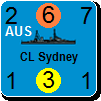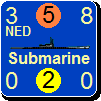Neilster
Posts: 2890
Joined: 10/27/2003
From: Hobart, Tasmania, Australia
Status: offline

|
quote:
ORIGINAL: Joseignacio
I was meaning that, at least in the pre-industrial stages they were using charcoal instead of regular coal for the manufacture of iron.
Charcoal the worst quality coal. Of course they probably had other sources than making coal out of wood, but they were probably scarce and very expensive.
Modern technicques may have let them discover and access more sources of mineral coal, but I wonder how much compared with the intensive use of coal that was needed, where the japanese authorities said something like " a bit of coal equals a drop of blood".
And yes, I read about POW working in previously closed mines, but I believe they were closed because of lack of manpower (as the final strain was taking all healthy man to the military, not because they were not profitable/efficient/quality before.
I know English is not your first language but charcoal is made from wood and coke is made from coal.
As an aside, this piece describes the Japanese extracting fuel from pine roots...
HE WAS A frail old fellow, dressed in loose-fitting clothes, working in his garden and chopping potatoes. Less than a year before, in 1945, he was in command of one of the largest fleets that had ever been assembled by any nation. His name was Takeo Kurita, vice admiral of the former Imperial Japanese Navy.
A young U.S. naval officer named Thomas Moorer and his translator approached Kurita. They explained to the admiral that they were working for a historical study group, gathering information about the war that had recently ended for Japan on such unfavorable terms. They asked Kurita if he would agree to discuss his experiences. And so began a series of interviews of the former Japanese military commander by representatives of the U.S. Strategic Bombing Survey, Naval Analysis Division.
“We Ran Out of Oil”
Kurita held nothing back. There were no state secrets any more. “What happened?” asked the American officer. “We ran out of oil,” replied Kurita, matter-of-factly.
Again and again during the interviews with Moorer and others, Kurita referred to a lack of fuel as the key reason that the Japanese forces were ground down to memories and ghosts. Kurita reflected on why his fleet was all but annihilated at the Battle of Leyte Gulf in October 1944. Kurita explained that he brought his ships into that action without knowing whether there was sufficient fuel to bring them out of the zone of combat. Thus, Kurita’s ships sailed slowly to their fate, conceding the element of surprise to the vigilant Americans, because the Japanese commanders were attempting to conserve enough fuel to return home. And so, lacking surprise, many of Kurita’s ships never had the opportunity even to turn around before being sent to the bottom by U.S. submarines and air power, along a track of sorrow that covered several seas.
Kurita explained that during the Leyte Gulf battle, he deployed his ships on a dangerous night passage through the San Bernardino Strait. “I was low on fuel,” he said. Kurita’s fleet tankers had been sunk or dispersed. The only fuel available to the Japanese ships was whatever was in their own tanks. “Fuel was an important consideration, the basic one,” said Kurita. There was not enough fuel for his ships to sail around the adjacent landmasses, so they were forced by necessity to transit the relatively narrow straits.
Several months after the Japanese disaster at Leyte Gulf, in February 1945, forces of the U.S. Navy and Marine Corps met with no naval resistance whatsoever during the invasion of Iwo Jima. The Japanese had simply conceded the sea and airspace around the island to the American attackers. The reason was that the Imperial Navy had elected to conserve fuel for the final defense of Japan.
By early 1945, almost all ships of the Japanese fleet had been deactivated. Powerful battleships, and even aircraft carriers, that had cost immense sums to construct before the war with the U.S. and during the early years of the conflict, were mere cold iron tied up to the pier for lack of fuel. Japan’s basic military decision-making process was not how to defend against American attacks on many fronts. Japan’s main effort was simply to struggle to preserve its dwindling levels of oil reserves.
Flying on Pine Needles
By mid-1944, Japan’s economy and its military were being starved of energy supplies, the consequence of an ever-tightening noose applied by U.S. and Allied air and naval forces. U.S. submarines sank hundreds of Japanese ships in this time frame, including critically needed tankers full of oil. The American submarine campaign against Japanese sea power all but cut off the sea lines of communication between Japan and its so-called “southern resource area.”
In desperation, Japanese war planners utilized every possible means to convert available resources into fuel substitutes. The Japanese manufactured alcohol from confiscated food supplies such as potatoes, sugar, and rice, thus forcing a direct competition between human stomachs and mechanical gas tanks. But alcohol has an energy content of about 65,000 Btu per gallon, whereas aviation gasoline delivers about 130,000 Btu per gallon. So on the best of days, Japanese aircraft took off with half the energy equivalent of their American counterparts in their fuel tanks. And aerial combat proved the disparity, with American aircraft utterly dominating the skies.
People in Japan were forced to tighten their belts even more when large amounts of garden vegetables began to be used for manufacturing lubricating oils. And even old rubber products such as tires and rain slickers were “distilled” to recover whatever oil could be had. But it was not enough.
By late 1944, the Japanese navy commenced a project to manufacture aviation fuel from pine tree roots. “Two hundred pine roots will keep an airplane in the sky for one hour,” said a Navy spokesman. The Japanese navy distributed over 36,000 kettles and stills, in which countless pine tree roots met their fate. Many a hillside of Japan was utterly denuded of trees. But each kettle or still could produce only about 4 gallons of raw product, and even that required significant treatment to upgrade to anything approaching usable fuel. Compounding the problem, each still required its own fuel supply, and this exacerbated an already severe fuel shortage in Japan. By one estimate, 400,000 Japanese worked full-time in order to support a dispersed, inefficient industrial base that could produce all of about 2,500 barrels of pine oil per day. In the end, a mere 3,000 barrels of “pine root” aviation fuel were ultimately delivered to the Japanese navy. And the pine derivative gummed up aviation engines after just a few hours of use. The entire project was a massive waste.
The Way to Lose a War
Many years later, the American naval officer Thomas Moorer had retired as a four-star admiral and chairman of the U.S. Joint Chiefs of Staff. In an interview, the retired American Adm. Moorer reflected on the retired Japanese Adm. Kurita that he had met long before. “He had been in command of the entire fleet,” recalled Moorer, “and now here he was digging potatoes.”
“The lesson I learned,” said Moorer, “was never lose a war.” And the American admiral added, “The way to lose a war is to run out of oil”
Cheers, Neilster
|
 Printable Version
Printable Version















 ), he explained me it was an optional that came in some of these yearly addenda to the rules (like Food in Flames, Factories in Flames, etc..) but not a home rule. I never cared to check.
), he explained me it was an optional that came in some of these yearly addenda to the rules (like Food in Flames, Factories in Flames, etc..) but not a home rule. I never cared to check. 



 New Messages
New Messages No New Messages
No New Messages Hot Topic w/ New Messages
Hot Topic w/ New Messages Hot Topic w/o New Messages
Hot Topic w/o New Messages Locked w/ New Messages
Locked w/ New Messages Locked w/o New Messages
Locked w/o New Messages Post New Thread
Post New Thread